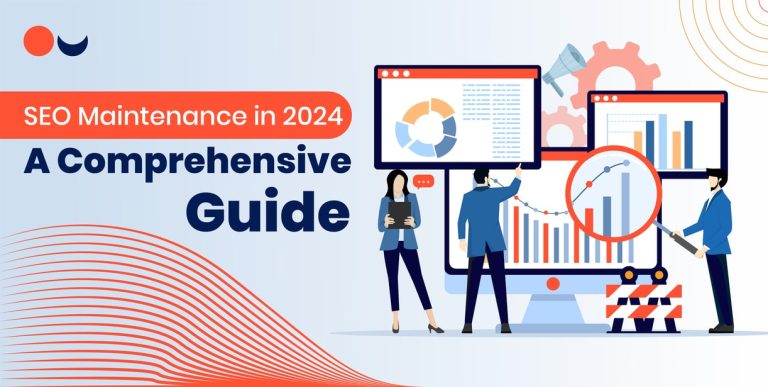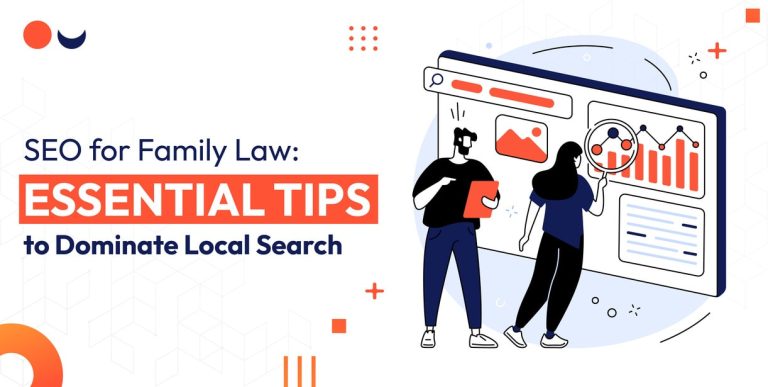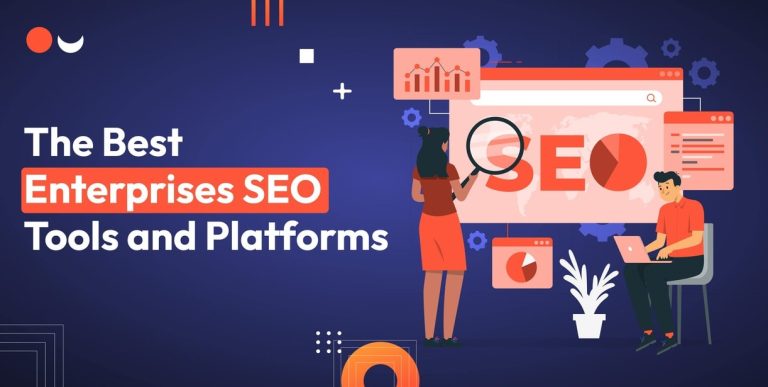In today’s world, search engines are always changing, and what people like online is always changing too. To ensure your website stays near the top when people search for things, you need to keep improving it. In this blog, we’ll talk about how to do that. We’ll share tips, tricks, and tools to help your website stay visible and competitive. Whether it’s making your content better or fixing technical stuff, we’ll help you understand SEO in 2024. By the end, you’ll know how to keep your website successful in the online world.
Fundamentals of SEO Maintenance
Effective SEO maintenance checklist for sustaining and improving your website’s search engine rankings in digital marketing services. This involves continuous efforts across several key components:
Technical Search Engine Optimization
Ensuring your website’s technical elements are optimized, including site speed, mobile-friendliness, XML sitemaps, and proper indexing. Regular audits are necessary to identify and fix issues that could impede search engine crawlers.
On-page Search Engine Optimization
Optimizing individual web pages to rank higher and earn more relevant traffic. This involves updating meta tags, headers, URLs, and images, ensuring keyword usage is strategic and relevant.
Off-page Search Engine Optimization
Activities are done outside your website to impact rankings, primarily involving building backlinks. Quality and relevant backlinks from authoritative sites enhance your site’s credibility.
Content Search Engine Optimization
Creating and optimizing content to attract both search engines and users. This involves keyword research, ensuring content relevancy, and updating existing content to keep it current and valuable.
Frequency of Tasks
Everyday SEO Maintenance
- Monitor site performance using tools like Google Analytics.
- Check for and fix broken links.
- Track keyword rankings in everyday SEO.
Weekly SEO Maintenance
- Analyze traffic and user behavior.
- Update blog content and other on-page elements as needed.
- Engage in link-building activities.
Monthly SEO Maintenance
- Conduct a thorough technical SEO audit.
- Review and update SEO strategies based on performance data.
- Perform a competitor analysis in monthly SEO maintenance.
Quarterly SEO Maintenance
- Comprehensive content review and update.
- Reassess goals and KPIs.
- Deep audit of backlinks and disavow harmful links if necessary.
Setting Goals and KPIs in Ongoing SEO Maintenance
You should figure out and keep an eye on important signs to see how well your SEO work is doing. Common KPIs include:
- Organic traffic: Measures the number of visitors coming from search engines.
- Conversion rate: Tracks the percentage of visitors completing desired actions.
- Bounce rate: Indicates the percentage of visitors who leave the site after viewing only one page.
- Keyword rankings: Monitors your position in search engine results for target keywords.
- Backlink profile: Evaluate the quantity and quality of backlinks with the link-building services.
Tools for Tracking SEO Performance
To monitor these KPIs, utilize tools like Google Analytics for traffic and user behavior insights, Google Search Console for indexing status and keyword performance, and other specialized SEO tools such as SEMrush or Ahrefs for comprehensive site audits and competitor analysis.
Technical SEO Maintenance
Keeping up with technical SEO means making sure your website is set up well for search engines and is easy for people to use. Here’s a comprehensive look at the critical aspects of technical SEO maintenance.
WordPress SEO maintenance
Site speed is a crucial factor in both user experience and search engine ranking. Slow-loading websites can lead to high bounce rates and lower conversion rates, as users are likely to abandon a site that takes too long to load. Moreover, search engines like Google consider site speed as a ranking factor.
Tools for Speed Testing
Several tools can help you assess and improve your website performance. Google PageSpeed Insights and Pingdom provide detailed reports on your site’s performance and offer suggestions for improvement. To enhance site speed, consider the following techniques:
- Image Compression
- Browser Caching
- Minify CSS, JavaScript, and HTML
- Content Delivery Network (CDN
Mobile Friendliness
With the majority of internet users accessing sites via mobile devices, Google has implemented mobile-first indexing, meaning it predominantly uses the mobile version of a site for indexing and ranking. To ensure your website performance is mobile-friendly:
- Responsive Design
- Viewport Configuration
- Mobile-Friendly Navigation
Site Structure and Navigation
A well-organized site structure helps search engines understand and index your content. It also enhances user experience by making it easier for visitors to find what they’re looking for. Techniques to improve navigation, such as:
- Hierarchical Structure
- Breadcrumbs
- Internal Linking
Indexing and Crawling
Make sure that search engine bots can easily index your site’s pages. This involves submitting an XML sitemap and using robots.txt to manage the crawling process.
Using Tools like Google Search Console
Google Search Console is invaluable for monitoring your site’s indexing status and identifying issues. However, the Google search console provides insights into which pages are indexed, crawl errors, and other critical SEO metrics.
Security and HTTPS
HTTPS secures data between your website’s performance and its visitors and serves as a ranking signal for search engines. Sites using HTTPS are perceived as more trustworthy. To implement HTTPS:
- SSL/TLS Certificate
- Redirect HTTP to HTTPS
- Mixed Content Issues
On-Page SEO Maintenance
On-page SEO maintenance ensures that each element of your website is On-Site optimization maintenance to enhance online visibility in search engine results and improve user experience. Here’s an in-depth guide to maintaining key on-page SEO components.
Keyword Research and Optimization
Keyword trends evolve, influenced by changes in user behavior, industry developments, and search engine algorithms. Regularly updating your keyword strategy ensures that your content remains relevant. Use tools like Google Trends to track keyword popularity over time and adjust your strategy accordingly.
Tools for Keyword Research
Tools like SEMrush, Ahrefs, and Moz provide comprehensive keyword research capabilities. These tools help identify high-volume, low-competition keywords, track keyword performance, and discover new keyword opportunities.
Off-Page SEO Maintenance
Off-page SEO maintenance is essential for building your website’s authority and driving traffic from external sources. Here’s a concise guide to the critical aspects of off-page SEO.
Backlink Profile Management
Backlink maintenance from authoritative and relevant websites is essential for SEO as it signals to search engines that your content is valuable and trustworthy. High-quality backlinks can boost your search engine rankings and drive organic traffic.
- Produce high-quality, shareable content such as blog posts, infographics, and videos that naturally attract backlinks.
- Engage in outreach campaigns to connect with influencers, bloggers, and industry leaders to promote your content and request backlinks.
- Write guest posts for a top-ranking website in your industry, including all the links back to your site.
- Keep an eye on your backlinks with tools like Ahrefs or SEMrush. If you spot any bad or spammy links, get rid of them to keep your backlink profile healthy..
Social Media Integration
While social media signals are not direct ranking factors, an active social media presence can enhance your SEO efforts by driving traffic, increasing content visibility, and fostering engagement.
- Regularly share engaging and relevant content on social media platforms.
- Engage with people by answering their comments, joining conversations, and sharing content they make.
- Add buttons on your website so people can easily share your stuff on social media. Tell them to share your stuff too.
Online Reputation Management
Online reviews significantly impact your reputation and can influence both user decisions and search engine rankings. Positive reviews build trust and credibility.
- Use tools like Google Alerts, Yelp, and ReviewTrackers to monitor reviews and mentions of your brand across various platforms.
- Promptly and professionally respond to all reviews, whether positive or negative. Address negative feedback constructively and thank users for positive reviews. This shows that you value customer feedback and are committed to improving your services.
Content SEO Maintenance
Content SEO maintenance is critical for ensuring that your website’s content remains relevant, engaging, and optimized for search engines. Here’s an overview of the key aspects of maintaining effective content SEO.
Content Quality and Relevance
High-quality content is essential for attracting and retaining visitors, earning backlinks, and improving search engine rankings. Quality content provides value, answers user queries, and establishes your site as an authoritative source.
- Use tools like SEMrush, Ahrefs, and Google Keyword Planner to find important words and topics for your content.
- Understand and address the search intent behind keywords. Create content that fulfills the needs and expectations of your target audience.
- Keep content current by updating statistics, facts, and examples. Regularly review and refresh older content to maintain its relevance and accuracy.
Content SEO Task Calendar and SEO Strategy
A content SEO task calendar helps you plan, organize, and schedule content creation and publication. It ensures consistency and helps you align your content with your marketing goals.
- Develop content around central themes or pillars, with related subtopics supporting them. This structure improves SEO and provides comprehensive coverage of subjects.
- Incorporate various content formats, such as blog posts, articles, videos, and infographics, to engage different audience segments.
- Establish a clear workflow for content creation, editing, and approval to maintain quality and consistency.
Multimedia Content
Multimedia content enhances user engagement, breaks up text, and provides alternative ways to consume information. It can also improve SEO by attracting more traffic and encouraging longer site visits.
- Use descriptive file names and alt text for images. Compress images to reduce load times without compromising quality.
- Optimize video titles, descriptions, and tags. Host videos on platforms like YouTube and embed them on your site to increase visibility.
- Create visually appealing and informative infographics. Optimize them with relevant keywords and share them across social media platforms to drive traffic.
User Engagement and Interaction
Engaging users in discussions can improve the perceived value of your content and enhance its SEO performance. Encourage comments by asking questions, inviting feedback, and responding to user input.
- Use tools like Google Analytics to track metrics such as time on page, bounce rate, and pages per session. These metrics help assess user engagement.
- Incorporate interactive elements like polls, quizzes, and surveys to engage users actively.
- Foster a sense of community by creating forums, hosting live chats, and promoting user-generated content. This boosts engagement and builds loyalty and repeat visits.
Local SEO Maintenance
Local SEO maintenance is essential for businesses looking to attract customers in their geographic area. Here’s a guide to the key elements of maintaining effective local SEO.
Google My Business (GMB)
Google My Business is a crucial tool for local SEO, providing visibility on Google Search and Maps. A well-optimized GMB profile helps attract local customers by displaying your business’s essential information, reviews, and updates.
- Ensure that your business name, address, phone number, and website are accurate and up to date.
- Select appropriate categories and attributes that describe your business.
- Regularly post updates, offers, and events to keep your listing active and engaging.
- Put really good pictures and videos to show off what you’re selling, offering, or where you work.
Local Citations and Listings
Local citations are mentions of your business’s name, address, and phone number on other websites and directories. These citations help search engines verify your business’s existence and credibility.
Consistent NAP information across all listings and citations is critical for local SEO. Inconsistencies can confuse search engines and potential customers, leading to lower rankings and trust issues.
- Ensure your business is listed on major directories like Yelp, Yellow Pages, and industry-specific directories.
- Periodically audit your citations to correct any discrepancies and update outdated information.
Customer Reviews and Ratings
Positive reviews and ratings significantly impact local SEO and customer trust. Encourage satisfied customers to leave reviews on Google, Yelp, and other relevant platforms.
- Ask for reviews via email, social media, and at the point of sale.
- Respond to all reviews, thanking customers for positive feedback and addressing negative feedback constructively. This shows that you value customer input and are committed to improving your services.
- Reviews influence local search rankings and customer decisions. A higher volume of positive reviews can improve your visibility and attractiveness to potential customers.
Understanding Content Decay
Content decay refers to the gradual decline in a piece of content’s visibility and effectiveness over time. In the competitive digital environment, where new content is constantly being published, older content can lose its relevance and struggle to maintain its position in search engine results pages (SERPs). To combat content decay effectively, consider implementing the following strategies:
Regular Content Audits
Conduct periodic audits of your website’s content to identify pages that are outdated, inaccurate, or underperforming. Update or remove obsolete content to ensure freshness and relevance.
Content Refreshment
Refresh existing content by updating statistics, facts, and examples. Incorporate current trends and insights to keep the content up-to-date and appealing to both users and search engines.
Repurposing Content
Repurpose successful content into different formats such as videos, podcasts, or infographics. This not only extends the lifespan of your content but also attracts different segments of your audience.
Historical Optimization
Review and optimize older content that was once high-performing but has seen a decline in website traffic. Improve SEO elements such as meta tags, headings, and internal links to boost its visibility. Best practices include:
- Keep titles under 60 characters, include primary keywords, and make them descriptive yet compelling.
- Write descriptions under 160 characters, provide a summary of the content, and include same keywords to encourage users to click through.
Adapting to Changes in Search Intent
Understanding and aligning with search intent is crucial for delivering content that satisfies users’ needs and preferences. Search engines increasingly prioritize relevance and user satisfaction, making it essential to adapt your seo services to evolving search intents. Here’s how you can adapt:
Intent-Based Keyword Research
Use keyword research tools to identify search queries and understand the intent behind them (e.g., informational, transactional, navigational). Optimize your content to address these intents effectively.
Analyzing SERP Features
Monitor SERPs to identify featured snippets, knowledge panels, and other rich results that dominate specific queries. Tailor your content to compete for these features by providing comprehensive and authoritative information.
User Engagement Metrics
Track metrics such as bounce rate, dwell time, and click-through rate to gauge how well your content meets user intent. Adjust your content strategy based on these insights to enhance engagement and relevance.
Managing Link Decay for Enhanced Authority
Links are a fundamental aspect of SEO, influencing a website’s authority and credibility. However, over time, links can decay due to factors such as broken links, changes in linking websites, or updates in search engine algorithms. To mitigate link decay and maintain strong SEO performance in 2024, consider the following strategies:
Backlink Audits
Regularly audit your backlink profile to identify and address broken or low-quality links. Use tools to monitor the health of your backlinks and disavow toxic links that could harm your site’s credibility.
Building Quality Backlinks
Focus on acquiring high-quality backlinks from authoritative websites within your industry. Develop relationships with influencers, industry experts, and media outlets to earn natural and relevant links over time.
Internal Linking Strategy
Strengthen your internal linking strategy to distribute link equity across your website. Use relevant anchor text and structure to guide users and search engines to important pages within your site.
Navigating Algorithm Changes
Search engine algorithms are continuously updated to improve the relevance and quality of search results for users. These algorithm updates, such as Google’s core updates, can significantly impact search rankings and traffic. To navigate algorithm changes effectively in 2024, consider the following strategies:
Stay Informed
Stay updated on industry news, official announcements from search engines, and insights from reputable SEO sources. Understanding upcoming algorithm changes and their potential impacts will help you prepare and adjust your SEO strategy accordingly.
Focus on User Experience
Prioritize user experience by ensuring fast loading times, mobile responsiveness, and intuitive navigation on your website. High-quality content that meets user needs and provides value will continue to be rewarded by search engines.
Ethical Search Engines Optimization Practices
Avoid manipulative or black-hat SEO tactics that could lead to penalties. Focus on white-hat SEO practices that align with search engine guidelines and emphasize organic growth and sustainability.
Monitor and Adapt
Continuously monitor your SEO performance metrics, including rankings, traffic trends, and conversion rates. Identify any fluctuations or anomalies that may indicate algorithmic changes and adjust your strategy promptly.
Frequently Asked Questions (FAQs)
What is ongoing SEO maintenance?
Ongoing SEO or SEO maintenance involves regular efforts to optimize a website for search engines. It includes updating content, improving technical aspects like site speed and mobile-friendliness, and acquiring quality backlinks to sustain and improve search engine rankings over time. This ongoing process ensures the website remains competitive in search results amidst evolving algorithms and industry trends.
Why SEO ranking reports aren’t reliable?
SEO ranking reports may not be reliable due to their momentary snapshot nature, fluctuating search engine algorithms, personalized search results, and varying user behaviors. They often lack context on competitive landscape changes, and keyword ranking, and can’t predict future rankings accurately. Regular monitoring and deeper analytics are needed for a more comprehensive SEO performance evaluation.
Does SEO need to be maintained?
Yes, SEO needs to be maintained because search engines continuously update algorithms, competitors evolve, and user behaviors change. Regular maintenance ensures that a website remains optimized, adapts to these changes, and sustains or improves its visibility in search engine results over time.
Is Search Engines Optimization a one-time thing?
No, SEO is not a one-time thing. It requires continuous effort and adaptation to remain effective. Search engine algorithms evolve, competitors make adjustments, and user expectations change, necessitating ongoing optimization to maintain or improve search rankings and traffic.
Why Is SEO an Ongoing Process?
SEO is an ongoing process because search engines frequently update their algorithms, requiring continuous adjustments to maintain or improve rankings. Competitors also evolve their strategies, and user behavior shifts, necessitating ongoing optimization of content, technical aspects, and backlinks to sustain visibility and relevance in search results over time.
Why is it important to continually monitor and update your SEO efforts?
Continually monitoring and updating SEO efforts is essential to adapt to changes in search engine algorithms, user behavior, and competitive landscapes. It ensures that your website remains relevant, maintains or improves its rankings, and meets evolving user expectations, thereby maximizing organic traffic and business outcomes.







